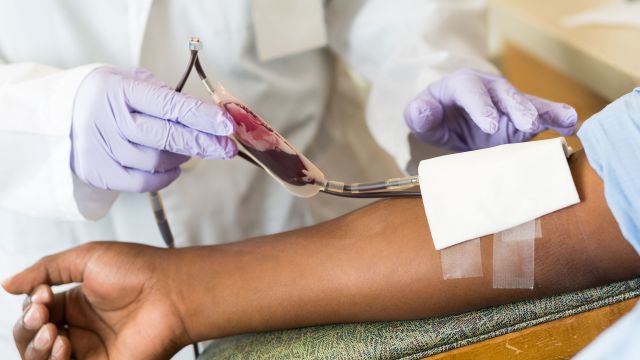Porphyrias are rare metabolic disorders that impact the body’s ability to produce heme. Heme is a natural compound needed to make red blood cells, transport oxygen to different areas of the body and perform other important biochemical functions. With porphyria, abnormal enzyme activity leads to the buildup of porphyrins, or heme precursors, compounds that occur during different stages of heme production. Different types of porphyria result in different accumulations of porphyrins, cause different symptoms and require different treatments.
Preventing attacks
Regardless of the type of porphyria a person has, avoiding triggers that can lead to flares or attacks is a major focus of treatment. Common porphyria triggers include consuming alcohol, smoking, exposure to sunlight, stress, fasting, crash diets, low carb diets, stress, certain medications and hormones. It is important that anyone who has a type of a porphyria work with their healthcare provider to identify triggers and come up with strategies for avoiding those triggers.
To prevent attacks, some patients may need to make dietary changes. Glucose inhibits porphyrin production, and it is recommended that people with porphyria consume adequate amounts of carbohydrates. Any changes to diet should be made under the guidance of a healthcare provider.
Hormonal medications may be prescribed as a preventative measure for women who experience porphyria symptoms due to hormonal fluctuations during the menstrual cycle.
Cutaneous porphyria treatments
Porphyrias can be divided into two broader categories depending on the symptoms they cause: cutaneous and acute. Cutaneous porphyrias affect the skin. When a person has a cutaneous porphyria, porphyrins accumulate in the skin, and the skin is oversensitive to sunlight. Exposure to sunlight results in blisters, itching and swelling. If you have a type of cutaneous porphyria, limiting sun exposure as much as possible is an important part of treatment. This includes wearing clothing that protects you from the sun, such as a wide-brimmed hat, gloves and a shirt with long sleeves. With treatment, sensitivity to sunlight lessens for many patients.
The staples of treatment for cutaneous porphyrias are therapeutic blood draws and antimalarial medications.
- Therapeutic blood draws. If you’ve ever donated blood or seen someone donate blood, this is the same procedure—a healthcare provider drains a pint of blood from a vein, usually in the arm. This helps to reduce the levels of iron and porphyrins in the liver, which can help reduce disease activity. This procedure is also called a therapeutic phlebotomy.
- Antimalarial medications. Two drugs used to treat malaria—hydroxychloroquine and chloroquine—may also be prescribed for some types of cutaneous porphyria. These drugs help reduce porphyrin levels.
These treatments are effective, and patients with cutaneous porphyria will typically have one or both. Patients may also need tests to monitor the health of the liver, because porphyria can damage the liver and lead to some types of liver disease.
Acute porphyria treatments
Acute porphyrias affect the nervous system—both the peripheral nerves close to the surface of the body, as well as the visceral nerves in the organs. These types can cause a wide variety of symptoms. Patients may experience pain, numbness, muscle weakness, paralysis, seizures, rapid heartbeat, trouble breathing and mental changes. They may also experience gastrointestinal symptoms, such as abdominal pain, nausea, vomiting, diarrhea and constipation, as well as problems urinating. Some acute porphyrias also cause skin symptoms in addition to neurological and/or gastrointestinal symptoms.
Treatments for acute porphyrias include:
- Hemin. This is an effective treatment that is recommended for all acute porphyrias. This is a form of heme that is given via an infusion, and helps normalize the levels of porphyrins in the liver. It’s prescribed during an attack or to prevent attacks, and multiple infusions are given on consecutive days.
- Glucose. Infusions of glucose may be given if hemin is not available, but is not a substitute for treatment with hemin. Glucose inhibits the production of porphyrins.
Managing the symptoms caused by acute porphyria is another focus of treatment, and healthcare providers may prescribe medications to help patients manage pain, nausea, anxiety or other symptoms.





